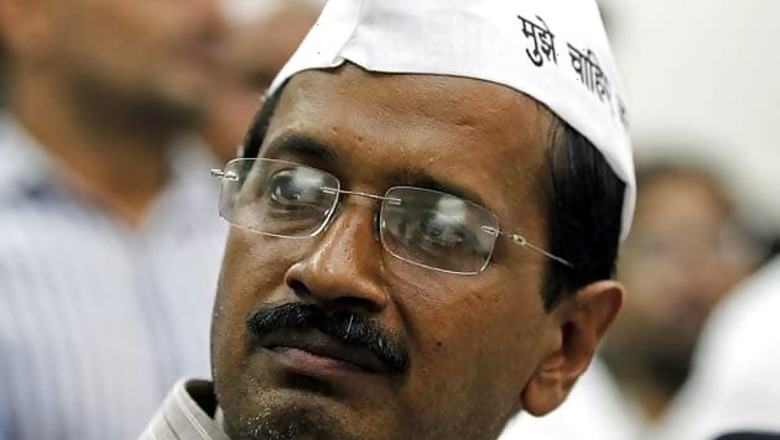
views
It is a fairy tale comeback for a party and leader who had been written off by everyone after the 49-day government in Delhi and the mauling in the 2014 Lok Sabha elections. But soon after the Lok Sabha election disaster, the much-maligned Aam Aadmi Party and its founder-leader Arvind Kejriwal started the ground work to regain Delhi's trust.
Faced with insurmountable odds, Kejriwal started by getting the basics right. Focusing solely on Delhi, the AAP did not take the electoral plunge in any other state elections.
Kejriwal started with doing the unthinkable. He tendered an apology to the Delhi voters claiming that he had made a mistake and not any crime by resigning in 49 days. What was considered his biggest handicap soon became his most potent weapon.
The voters, unaccustomed to politicians apologising, came to Kejriwal's rescue and decided to give him one more chance. With stories of how corruption had come down during his brief rule, the Delhi voter flocked to AAP as the party gathered strength.
Here is what worked for AAP and Kejriwal in Delhi:
1) Arvind Kejriwal's image, his apology and fighting elections on his name
Despite accusations of AAP accepting donations from fake companies, Arvind Kejriwal and his followers came out as the cleanest of the lot. His image of an anti-corruption crusader, apologising for his mistake, a nature alien to the Indian politician, and AAP going into the election projecting him as the chief ministerial candidate worked for the party.
2) Started campaigning 3-4 months back
AAP started to campaign in Delhi by mid 2014 October with its volunteers and leaders fanning out across the national capital. They initiated direct contact with the electorate and visited almost every Delhi voter. The door-to-door campaign, padyatras and street corner meetings had much more visibility that the high profile rallies of its rivals. The voters felt a direct connect with AAP candidates which are reflected in the superlative show.
3) Sticking to local and constituency specific issues
Kejriwal raised constituency and Delhi specific issues eschewing the big talk of BJP and Congress. Problems of power, water, sanitation, women's safety, lack of schools and colleges in some areas were raised prominently and AAP concentrated on explaining how Kejriwal's government would implement the election promises.
4) Anti-corruption stand along with the promise of slashing of power and water tariffs
With petty corruption emerging as one of the biggest electoral issue in Delhi and hitting the common man directly, Kejriwal promised to end it. His supporters and AAP leaders claimed that corruption had come down during his rule which was also supported by the voters.
AAP's promise to cut down electricity and water tariff was a major draw in unauthorised, resettlement colonies, slums and the poorer sections of the society who came out in large numbers to back Kejriwal.
5) Slugging it out in Delhi after Lok Sabha debacle
Kejriwal decided to stick with Delhi after the Lok Sabha debacle and strengthened his party which was hit by desertions. He brushed off the charge of being a dictator and gave his candidates a free hand to raise local issue but at the same time kept a hawk eye on their performance. He did not fail to pull them up if the candidate was found to be lacking.
6) Collapse of Congress
With Congress lurching for one electoral defeat to another, the party's traditional vote bank shifted to the AAP. Dalits, Muslims and the poor moved enbloc to AAP, giving the party a major boost.
7) Divided BJP and the negative campaign
BJP was a badly divided house in Delhi and its leadership could not project a chief ministerial candidate when they were still in the race giving AAP the headway. The party never came up with a positive agenda believing that it was on a roll and would win Delhi easily riding on the Narendra Modi wave.
BJP's advertisement targeting Kejriwal and calling him "upadravi gotra" did not go down well with the voters. Their series of questions to Kejriwal also worked in AAP's favour and the BJP itself had no answer how they would solve Delhi's problems.
8) Overreliance on Narendra Modi
The Narendra Modi card failed badly in Delhi. A man who always leads from the front, Modi addressed poorly attended rally which sent alarm bells ringing in the party. BJP President Amit Shah then brought in an army of 120 MPs, over 20 Union ministers, several state chief ministers and leaders creating the impression that they were in the panic mode. Kejriwal used the deployment of the massive BJP election machinery to his advantage as people saw in him a David taking on the Goliath.
9) Kiran Bedi's projection as CM
With Kejriwal going all out to project that BJP did not have a capable leader in Delhi and Modi was not going to become the CM, the party belatedly brought in Kiran Bedi. But she proved to be a big disaster creating more divide within the party. A very poor orator, Bedi was seen as a loner and dictator alienating the common BJP worker. Her elevation also ended hopes of other local leaders who kept away from campaigning.
10) Challenging BJP leaders directly
Kejriwal was called "bhagoda" (runaway) by his rivals but he never shied away from taking on the opposition. He challenged Kiran Bedi for a debate but she never replied to it giving out the impression that BJP had no concrete plan for Delhi.



















Comments
0 comment